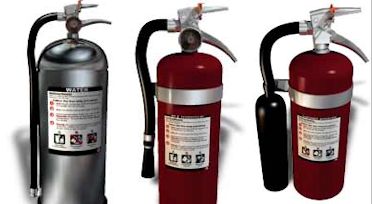Types of Fire Extinguishers
Different types of fire extinguishers are designed to fight different types of fire.

The three most common types of fire extinguishers are: air pressurized water, CO2 (carbon dioxide), and dry chemical. The copy below provides information regarding the type of fire and which fire extinguisher should be used.
Dry Chemical
Dry Chemical extinguishers are usually rated for multiple purpose use. They contain an extinguishing agent and use a compressed, non-flammable gas as a propellant.
Halon
The bromochlorodifluoromethane (Halon 1211) fire extinguisher has an agent that is similar to carbon dioxide in that it is suitable for cold weather installation and leaves no residue. It is important to note that the production of Halon has been phased out because of the environmental damage it causes to the earth’s ozone.
There are several alternative clean agents similar to halon in that they are nonconductive, noncorrosive, and evaporate after use, leaving no residue. Larger models of these fire extinguishers are listed for Class A as well as Class B and Class C fires. When discharged, these agents are in the combined form of a gas/mist or a liquid, which rapidly evaporates after discharge with about twice the range of carbon dioxide.
Water
These extinguishers contain water and compressed gas and should only be used on Class A (ordinary combustibles) fires.
Carbon Dioxide
Carbon Dioxide (CO2) extinguishers are most effective on Class B and C (liquids and electrical) fires. Since the gas disperses quickly, these extinguishers are only effective from 3 to 8 feet. The carbon dioxide is stored as a compressed liquid in the extinguisher; as it expands, it cools the surrounding air. The cooling will often cause ice to form around the horn where the gas is expelled from the extinguisher. Since the fire could re-ignite, continue to apply the agent even after the fire appears to be out.
Knowledge Check Choose the best answer for the question.
5-5. Which of the following extinguishers is usually rated for multiple purpose use?
You forgot to answer the question!
